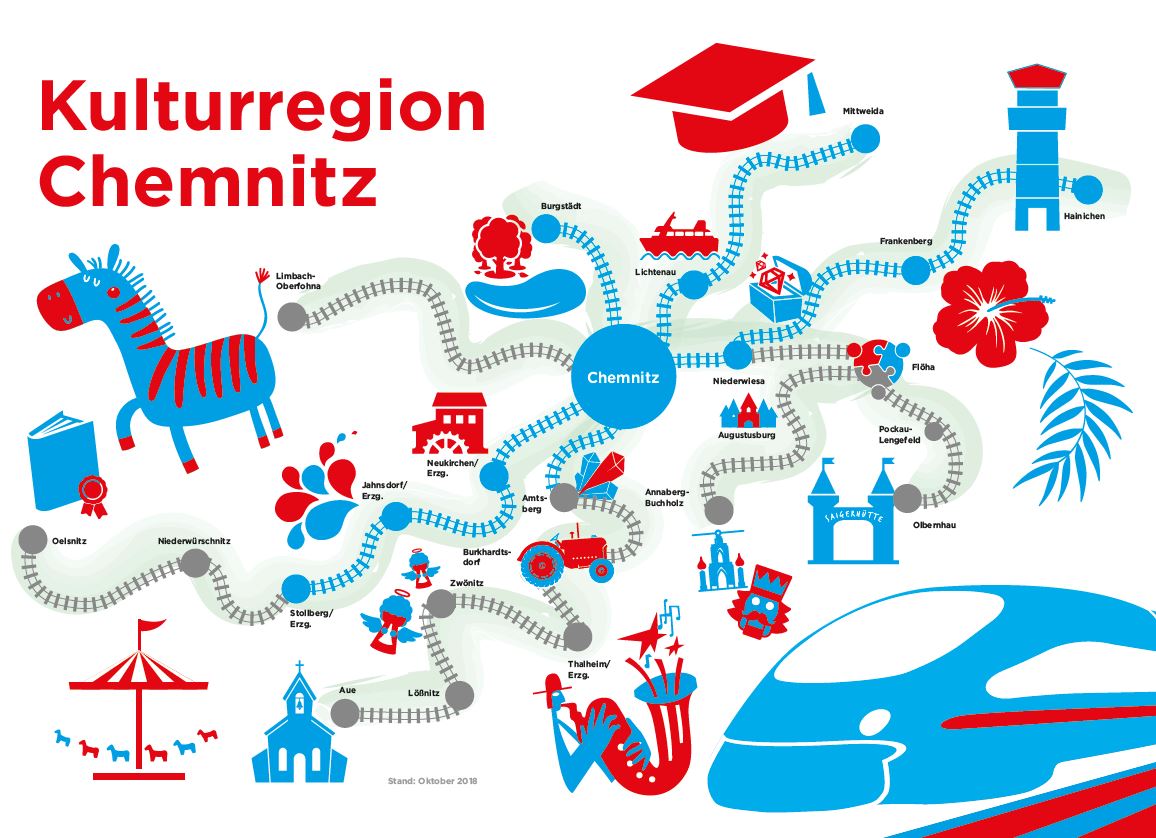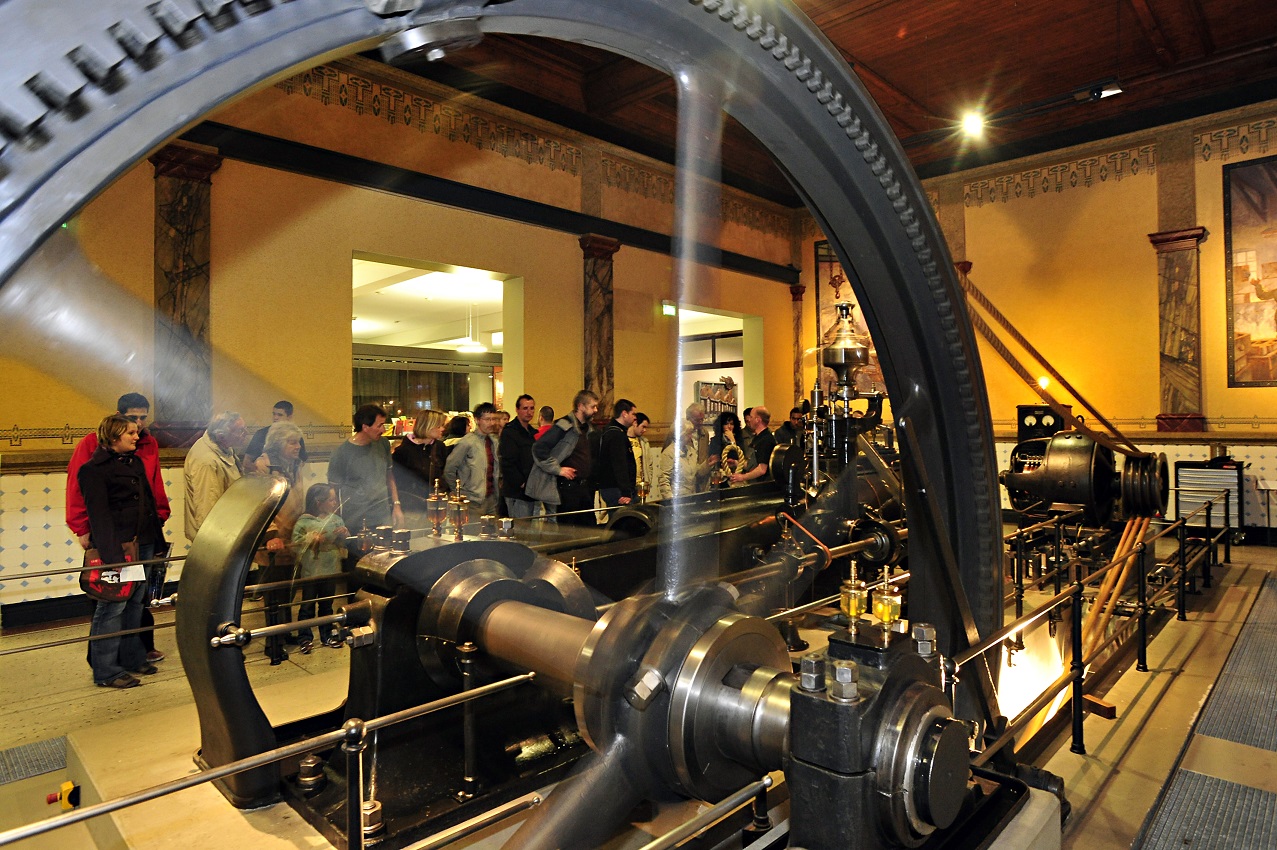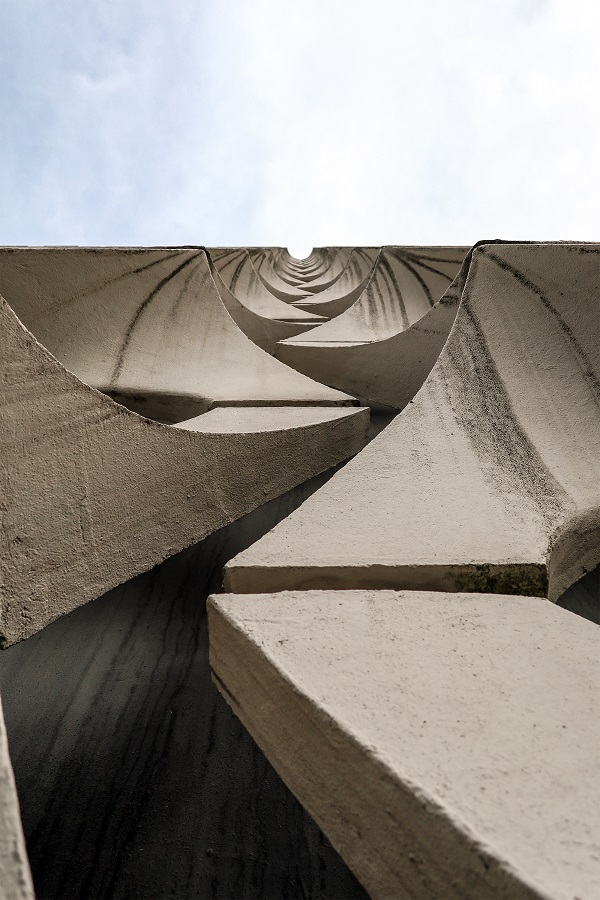On 30 September we submitted our application for the title of European Capital of Culture 2025 to the Cultural Foundation of the German Federal States in Berlin.
We are now officially a candidate city. And in case you were in any doubt about our chances because of the strong competition in Germany: Here are our
25 top reasons!
Why Chemnitz has what it takes to become European Capital of Culture.
- 25. We’ve got the tallest work of art in the world
Smokestacks used to dominate the skyline back when Chemnitz was one of Germany’s leading industrial cities. Today, our stack stands a colossal 302 metres high, and, decorated in 168 brightly coloured LEDs in a design by French artist Daniel Buren, is considered the world’s tallest work of art. (Photo: eins/Zschage)
- 24. We’re from Karl-Marx-Stadt
There is no one in the world aged between 30 and 65 who can claim to have been born in “Chemnitz”. It’s a fascinating aspect of a civic history that is closely intertwined with the upheavals and new beginnings in Europe.
- 23. We are home to Saxony’s most international university
With some 3,000 international students ‒ that’s over 25 per cent of the student body ‒ TU Chemnitz is the most international university in Saxony, and is a front runner in the Germany‑wide rankings, too. People from over 90 nations study, research and teach at TU Chemnitz.
- 22. We take a stand
No city has ever put together a city-centre concert that attracted 65,000 people faster than Chemnitz did. #wirsindmehr in September 2018 was the moment we knew it for sure: European Capital of Culture is right up our street.
- 21. We’ve got the “Chemnitzer Modell”
Explore the region by tram – Mittweida, Hainichen, Aue, Oelsnitz, Limbach-Oberfrohna, Burgstädt, Annaberg-Buchholz, Olbernhau… Local public transport will be opening up the region over the next few years, and as a cultural region we plan to make that a real experience. Sometimes the best things are right under your nose.
- 20. We’re always coming up with something
There’s a good reason why the German Patent Act was drawn up by the mayor of Chemnitz, Dr. Wilhelm André. By the 19th century, Chemnitz had become a well-respected industrial city, thanks in part to a wide range of inventions that were so good they needed to be protected from imitators. The number of patent applications from Chemnitz in 1891 was apparently six times the national average. And the tradition continues today: we remain masters of invention.
- 19. We make our festivals accessible
The Barrier-Free Festival is a project run by the KulTh e.V. cultural association in Chemnitz. The association provides advice on how festivals can meet the needs of people with special requirements e.g. wheelchair users, people with Down’s Syndrome, the visually impaired, people with autism, and people with severe multiple disabilities. A team of volunteers is on hand around the clock to offer direct assistance and support in the event of any questions or issues. At the Kosmonaut Festival, for instance, there’s a barrier-free camp, power points for recharging electric wheelchairs and a cool place for storing medications. So there are no barriers to having a fantastic experience – at the same time, in the same space. As the KulTh e.V. motto has it: Culture. Involvement. Inclusion.
- 18. We’ve got a KRACH team
This funding programme for art and culture start-ups provides rent-free commercial space for up to three years in a buzzing, up-and-coming creative area. Grant winners receive a starting budget of EUR 5,000 and expert advice on setting up a business. So, in two rounds of funding so far, 15 spaces have been allocated to young designers, software developers and even a centre for performing arts. KRACH got its inspiration from Bologna’s successful IncrediBOL! programme and has served the needs of the cultural and creative industries in Chemnitz since 2018.
- 17. We are sports-mad
And we’ll blow the competition away! Over 10,000 people take part in the Company Run, the Heavy 24 (the biggest 24-hour mountain bike race in the former East Germany), the Reservoir Marathon, the Fichtelberg Ultra Marathon, the Chemlympics, the Slackfest, the Nachtskaten (Evening Skate), the Bring Da TruckaZ… We are host to many top-class sports and have the ideal conditions for young competitive athletes. Sport is simply in the Chemnitz DNA and an integral part of the city’s culture.
- 16. We are passionate campaigners
Managing to save the viaduct as a monument to industrial heritage is a remarkable example of civic engagement. But it’s far from being the only example. The Kassberg Prison Education and Memorial Site, the Tram Museum and the Saxon Motoring Museum, the Karl-Schmidt-Rottluff Buildings, the Küchwaldbühne (Küchwald Forest Theatre), the railway premises in Hilbersdorf – these are just some of the conservation projects that speak volumes about the passion Chemnitz residents have for their city.
- 15. We have a steadily growing open-air gallery
Thanks to cooperation between regional and international artists ‒ a collaboration that spans categories and generations ‒ Chemnitz is becoming more colourful by the day. Besides being a forum for knowledge transfer and artistic exchange, the project also aims to promote social cohesion. (Photo: Rebel Art)
- 14. We’ve got a lot of space
Chemnitz is brimming with space for experimentation; we’ve got plenty of room for ideas. We want to maximise its potential over the next few years – preferably by working with creative minds from all over the world. So the title of our cultural strategy for 2030 is self-explanatory: Making Space for Culture.
- 13. We help you to discover the meaning of Eastmodern
We’ve had to do a lot of soul-searching about our cityscape: we don’t have cute dinky streets, or an old town, and we don’t go in for any pomp and ceremony. In short, we’re not like most cities! But isn’t that a gift in itself? 30 years after the wall came down, interest in GDR history and reunification is noticeably on the increase, including the architecture and design of that era. We’ve got lots to say on the subject, lots to work through, and lots to show as well. (Photo: Martin Maleschka)
- 12. We’ve got one of the oldest natural monuments around
Chemnitz sits on volcanic rock. Around 291 million years ago, a volcano erupted, burying everything in its path – a disaster that now represents a stroke of luck for us today, since the ashes preserved the plants and animals that came before us. Thus, not only have we been able to excavate our Petrified Forest, which has become one of the world’s most important collections of petrified wood, we have also discovered many more scientific gems, such as a horse tail tree measuring several metres. The EU-funded project Window on the History of the Earth continues to give children in particular the opportunity to learn all about these palaeontological finds at a purpose-built excavation site.
- 11. We’re big fans of micro projects
It all started two summers ago. On our journey towards becoming European Capital of Culture 2025, we wanted to inspire people to get involved in city life – so we set up a funding scheme for micro projects. It was a great hit, as lots of projects are still up and running today. We gave the movers and shakers a helping hand, offering them up to EUR 2,500 to organise all kinds of workshops, presentations, conferences, lectures, new event formats, artistic experiments, debates, cross‑cultural encounters, district projects, fan culture, themed walks – a little nudge to help them take that small step from “They should…” to “Let’s just do it…” In total, just under 200 applications were submitted over the past two years, and 43 projects have been awarded approximately EUR 73,000 in funding. A jury made up of Chemnitz residents appointed by the programme council is responsible for project selection. (Photo: Ernesto Uhlmann)
- 10. Our economy promotes culture
This February saw the foundation of KLUB 2025, an initiative bringing together regional businesses, chambers of commerce and financial institutions, under the motto “Culture needs business – Business needs culture”. Its aim is to support Chemnitz in its bid to become European Capital of Culture 2025 and to provide funding to develop the region’s cultural programme.
- 09. We live our industrial culture
In 2020 we are hosting Boom. 500 Years of Industrial Culture in Saxony – a celebration of five hundred years of balancing work and life, technology and the Zeitgeist, economic success and cultural revival. The many well-preserved sites in our region bearing witness to its engineering history are a lively illustration of the Industrial Age, the city’s identity and the importance to it of local art and culture. (Photo: Sven Gleisberg)
- 08. We have a great Friends’ Association
Since 2017, the Association ‒ which declares itself to be “of, and for, the people of Chemnitz, fully supporting the city’s bid and pledging to do all we can to assist the project in any way” ‒ has offered both highly constructive and critical advice throughout the process. At public picnics and on regular tram trips, members chat to Capital of Culture enthusiasts and sceptics alike. They also attend the Jour Fixe Kultur event held on the first Monday of every month to discuss various aspects of cultural life in the city. And as if that weren’t enough, the Friends have also set up the Fahrradkonzerte (Cycle Concerts), and continue to encourage more and more people to get involved with the bid. So, for anyone who’s interested, the Association meets once or twice a month at different locations in the city. Find out more at: www.freundeskreis-chemnitz-2025.de
- 07. We’ve got a flair for festivals
The theatre world has its Tanz | Moderne | Tanz and Nonstop Europa festivals; the Begehungen and Pochen events celebrate art; the Hutfestival honours circus acts; RAW explores industrial culture; and the International Film Festival Schlingel shines a spotlight on films for children and young people. Meanwhile, all over Germany, Chemnitz inhabitants are building stages and entire festival sites, or working hard behind the scenes so that large-scale events like Kosmonaut, Splash, With Full Force, Wave Gothic and many others can go off with a bang. Forgotten something? Undoubtedly. With festival fever it happens all the time!
- 06. We’ve got a swimming pool like no other
Designed by Director of Urban Planning Fred Otto and opened in 1935, our municipal baths were once among the largest and most modern indoor pools in Europe. Even today they continue to attract visitors and photographers from all over the world. Not to mention the fact that it also made a perfect backdrop for our ballet, and for the launch of our application to become European Capital of Culture 2025. (Photo: Ulf Dahl)
- 05. Our bid is in
We’ve passed the first milestone on the path to becoming Capital of Culture: our 20-page bid book was submitted on time to the Cultural Foundation of the German Federal States, which is running the national selection process for European Capital of Culture 2025.
- 04. Chemnitz is not done yet
In recent years, cities selected as Capitals of Culture cities have not traditionally been amongst Europe’s cultural hotspots. Today they are. Because they have highlighted culture when reflecting on their future – and gained quality of life, identity, self-confidence, tourists… Chemnitz too has chosen the same path, and the plan is for culture to set the agenda for the city’s development. Because by promoting a culture of dialogue; a willingness to experiment and give creativity the room it needs to flourish; and openness to innovation and ideas about how to create a diverse and welcoming city life, we can turn Chemnitz into a city we want to grow old in. A city that has shaken off the images and issues that dominated last year’s news.
- 03. We are straightforward
Chemnitz is an industrial city. That makes an impression – including on artists and designers. Sculptor and Bauhaus artist Marianne Brandt, for example, who helped shape modern design in Europe, and in whose honour the exhibition “I am all glass” opened at the Museum of Industry. Or sculptor Clauss Dietel, who had a major impact on East German design, from his ball-shaped loudspeaker to the Erika typewriter to his car and moped designs, and whose collection, as was unanimously decided on Thursday by the Culture Committee, is being donated to the Kunstsammlungen Chemnitz (Chemnitz Art Collections).
- 02. We breathe mountain air
Not always, but whenever we can. Particularly now, when we have the opportunity to learn so much from the Erzgebirge/ Krušnohoř Mining Region about winning major titles and how to work alongside other places in the region on a shared cultural strategy, we’ll definitely be catching up with our neighbours more often than just at Christmas. Even if things continue to be at their most beautiful in December: mining parades, Christmas markets, Schwibbögen (candle-holders), Räucherkerzchen (“smoking candles”)… ski slopes, Kammloipe cross‑country trails… The Erzgebirge and their unique traditions are only a stone’s throw from us – even though we Chemnitzers may never utter its famous mining greeting, “Glück auf”.
- 01. We are all about New Beginnings
If Chemnitz has anything in its blood, it’s new BEginnings: Germany’s leading industrial city at the start of the 20th century, Central Eastern Europe’s leading mechanical engineer during the Cold War, and emerging medium-sized economic hub since the turn of the millennium. Whatever radical changes history may have brought, the people of Chemnitz have made new BEginnings possible with a can-do attitude and an inventive spirit. Nevertheless, the city’s fractured history has also carved deep incisions that can still be felt today. Three different city centres in 70 years, two different names, various social systems – Chemnitz is still searching for its identity and self-image. The application to become European Capital of Culture in 2025 will make an important contribution to this search. It will tell a story about Chemnitz that will give the momentous impact of European history a face, a fate – new beginnings. Transformation.







Get Social